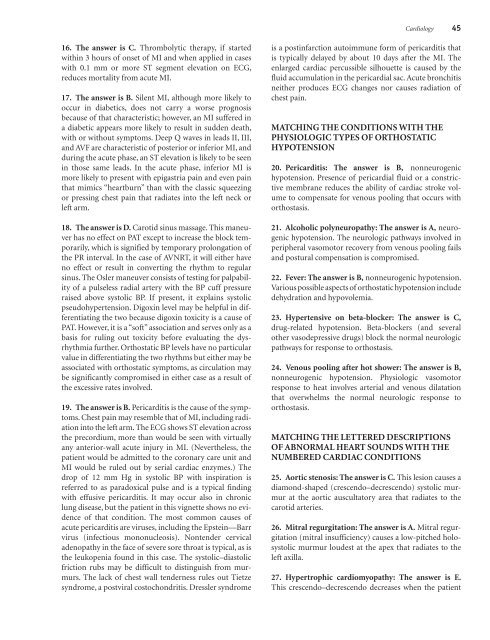NMS Q&A Family Medicine
NMS Q&A Family Medicine
NMS Q&A Family Medicine
- No tags were found...
Create successful ePaper yourself
Turn your PDF publications into a flip-book with our unique Google optimized e-Paper software.
Cardiology 4516. The answer is C. Thrombolytic therapy, if startedwithin 3 hours of onset of MI and when applied in caseswith 0.1 mm or more ST segment elevation on ECG,reduces mortality from acute MI.17. The answer is B. Silent MI, although more likely tooccur in diabetics, does not carry a worse prognosisbecause of that characteristic; however, an MI suffered ina diabetic appears more likely to result in sudden death,with or without symptoms. Deep Q waves in leads II, III,and AVF are characteristic of posterior or inferior MI, andduring the acute phase, an ST elevation is likely to be seenin those same leads. In the acute phase, inferior MI ismore likely to present with epigastria pain and even painthat mimics “heartburn” than with the classic squeezingor pressing chest pain that radiates into the left neck orleft arm.18. The answer is D. Carotid sinus massage. This maneuverhas no effect on PAT except to increase the block temporarily,which is signified by temporary prolongation ofthe PR interval. In the case of AVNRT, it will either haveno effect or result in converting the rhythm to regularsinus. The Osler maneuver consists of testing for palpabilityof a pulseless radial artery with the BP cuff pressureraised above systolic BP. If present, it explains systolicpseudohypertension. Digoxin level may be helpful in differentiatingthe two because digoxin toxicity is a cause ofPAT. However, it is a “soft” association and serves only as abasis for ruling out toxicity before evaluating the dysrhythmiafurther. Orthostatic BP levels have no particularvalue in differentiating the two rhythms but either may beassociated with orthostatic symptoms, as circulation maybe significantly compromised in either case as a result ofthe excessive rates involved.19. The answer is B. Pericarditis is the cause of the symptoms.Chest pain may resemble that of MI, including radiationinto the left arm. The ECG shows ST elevation acrossthe precordium, more than would be seen with virtuallyany anterior-wall acute injury in MI. (Nevertheless, thepatient would be admitted to the coronary care unit andMI would be ruled out by serial cardiac enzymes.) Thedrop of 12 mm Hg in systolic BP with inspiration isreferred to as paradoxical pulse and is a typical findingwith effusive pericarditis. It may occur also in chroniclung disease, but the patient in this vignette shows no evidenceof that condition. The most common causes ofacute pericarditis are viruses, including the Epstein—Barrvirus (infectious mononucleosis). Nontender cervicaladenopathy in the face of severe sore throat is typical, as isthe leukopenia found in this case. The systolic–diastolicfriction rubs may be difficult to distinguish from murmurs.The lack of chest wall tenderness rules out Tietzesyndrome, a postviral costochondritis. Dressler syndromeis a postinfarction autoimmune form of pericarditis thatis typically delayed by about 10 days after the MI. Theenlarged cardiac percussible silhouette is caused by thefluid accumulation in the pericardial sac. Acute bronchitisneither produces ECG changes nor causes radiation ofchest pain.MATCHING THE CONDITIONS WITH THEPHYSIOLOGIC TYPES OF ORTHOSTATICHYPOTENSION20. Pericarditis: The answer is B, nonneurogenichypotension. Presence of pericardial fluid or a constrictivemembrane reduces the ability of cardiac stroke volumeto compensate for venous pooling that occurs withorthostasis.21. Alcoholic polyneuropathy: The answer is A, neurogenichypotension. The neurologic pathways involved inperipheral vasomotor recovery from venous pooling failsand postural compensation is compromised.22. Fever: The answer is B, nonneurogenic hypotension.Various possible aspects of orthostatic hypotension includedehydration and hypovolemia.23. Hypertensive on beta-blocker: The answer is C,drug-related hypotension. Beta-blockers (and severalother vasodepressive drugs) block the normal neurologicpathways for response to orthostasis.24. Venous pooling after hot shower: The answer is B,nonneurogenic hypotension. Physiologic vasomotorresponse to heat involves arterial and venous dilatationthat overwhelms the normal neurologic response toorthostasis.MATCHING THE LETTERED DESCRIPTIONSOF ABNORMAL HEART SOUNDS WITH THENUMBERED CARDIAC CONDITIONS25. Aortic stenosis: The answer is C. This lesion causes adiamond-shaped (crescendo–decrescendo) systolic murmurat the aortic auscultatory area that radiates to thecarotid arteries.26. Mitral regurgitation: The answer is A. Mitral regurgitation(mitral insufficiency) causes a low-pitched holosystolicmurmur loudest at the apex that radiates to theleft axilla.27. Hypertrophic cardiomyopathy: The answer is E.This crescendo–decrescendo decreases when the patient
















